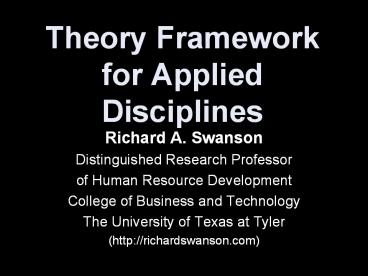Theory Framework for Applied Disciplines - PowerPoint PPT Presentation
Title:
Theory Framework for Applied Disciplines
Description:
Theory Framework for Applied Disciplines Richard A. Swanson Distinguished Research Professor of Human Resource Development College of Business and Technology – PowerPoint PPT presentation
Number of Views:197
Avg rating:3.0/5.0
Title: Theory Framework for Applied Disciplines
1
Theory Framework for Applied Disciplines
- Richard A. Swanson
- Distinguished Research Professor
- of Human Resource Development
- College of Business and Technology
- The University of Texas at Tyler
- (http//richardswanson.com)
2
(No Transcript)
3
HRD Theory Basic Readings
- Lynham, S. A. (2002a). Theory building in applied
disciplines Advances in developing human
resources. 4(3). - Lynham, S. A. (2002b). The general method of
theory-building research in applied disciplines.
Theory Building in Applied Disciplines Advances
in Developing Human Resources. 4(3), 221-237. - Swanson, R. A. (2001). Human resource development
and its underlying theory. Human Resource
Development International. 4(3), 299-312. - Torraco, R. J. (2005). Theory development
research methods. In R. A. Swanson E. F. Holton
(Eds.), Research in Organizations Foundations
and Methods of Inquiry. San Francisco
Berrett-Koehler. 351-374.
4
(No Transcript)
5
- Scholars rarely, if ever, set forth the core
theory of their applied disciplines or a formal
theoretical structure for discussing, organizing,
or advancing their disciplinary view of theory
and its components.
6
- In discussing their applied disciplines,
scholars have relied on ... - the perspective of being interdisciplinary.
- dead-end philosophical debates as to the
definition and purpose of the discipline.
7
Theory state buzzing, blooming, and confusing
Van de Ven (1999)
- Theory discussions and theory research are not
held together in a manner that allows
interpretation and integration. - There is a sense of randomness and incoherence to
theory discussions and developments.
8
Problem
- Theory development research methodologies do not
directly address theory in relation to bounding
and defining the core theory of applied
disciplines.
9
The PURPOSE of a holistic Theory Framework for
Applied Disciplines.
- .. is to help scholars and practitioners create
and critique the theory of an applied discipline,
as well as the components within it, for the
purpose of advancing the discipline.
10
Methods that Constrain
- Taking a phenomena that is believed to fall
within the realm of a particular discipline,
without addressing the discipline itself, and
exploring the theory of that phenomena. - Taking a phenomena of an existing theory and
extending the theory by subdividing it, or
increasing detail in terms of adding units. - Taking a research-only or a practice-only
approach to explain a phenomena.
11
Theory Framework Design Criteria
- should articulate the name of the discipline and
the purpose of the discipline with enough
precision to determine what could be considered
to be within or outside the purview of that
discipline. - should function at multiple levels from
establishing and confirming disciplinary
boundaries down to the smallest possible unit
deemed logical and potentially useful. - should consider, mediate, and articulate
researcher and practitioner perspectives in its
language, components, and structure.
12
Six Components
Theory Framework for Applied Disciplines
13
(No Transcript)
14
Boundary of the Theory of an Applied Discipline
- The boundary of the theory of an applied
discipline is established by specifying its name,
definition, and purpose along with assumptions or
beliefs that conceptually frame the theory and
practice of that discipline.
15
Contributing Theories for an Applied Discipline
- The contributing theories are selected theories
that fundamentally address the definition,
purpose, and assumptions under-girding an applied
discipline.
16
Core Theory for an Applied Discipline
- The core theory of an applied discipline is the
intersection and integration of the contributing
theories that operationalize the definition,
purpose, and assumptions of an applied
discipline.
17
Useful Theory for an Applied Discipline.
- The theory of a phenomenon that is outside the
core theory of an applied discipline and within
the intersection of two contributing theories
that has utility in explaining an important realm
of practice within the discipline.
18
Novel Theory for an Applied Discipline.
- The theory of a narrow phenomenon that is
related to an aspect of the applied discipline
under consideration that could logically provide
an unusual explanation of how it works.
19
Irrelevant Theory for an Applied Discipline.
- Any theory that falls outside the theory
boundary, contributing theories, core theory, and
useful theory of the applied discipline under
consideration with no compelling evidence as to
its usefulness or logic supporting its potential
for a novel contribution.
20
Academy of Human Resource Development Human
Resource Development Reviewhttp//www.theoryprac
tice.net/Theory Committee Members
- W. Clayton Allen
- Ross E. Azevedo
- Reid A. Bates
- Larry M. Dooley
- Toby M. Egan
- Sharon K. Gibson
- Tobin P. Lopes
- Susan A. Lynham
- Wim J. Nijhof
- Wendy E. A. Ruona
- Darlene Russ-Eft
- Julia Storberg-Walker
- Richard J. Torraco
- John S. Walton
- Greg G. Wang
- Baiyin Yang
- Lyle Yorks
21
EXERCISE TASK
- Work on the assumptions that
- the ___ profession is moving full speed in
supporting the Theory Framework for Applied
Disciplines for ___ and - (2) that the profession commissioned 4-5 leading
scholars to create their version of the theory
framework for the discipline. - Create two scenarios of the future-- one positive
and one negative-- that could result following
the completion of the 4-5 scenarios.

